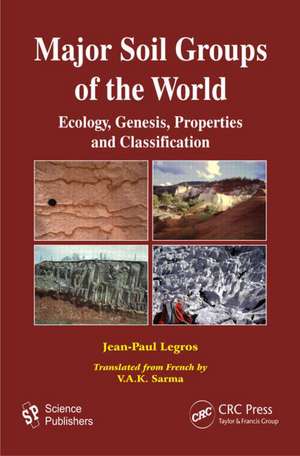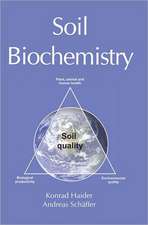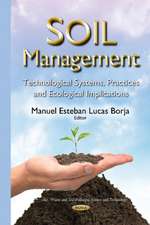Major Soil Groups of the World: Ecology, Genesis, Properties and Classification
Autor Jean-Paul Legrosen Limba Engleză Hardback – 20 sep 2012
Preț: 1339.62 lei
Preț vechi: 1633.68 lei
-18% Nou
Puncte Express: 2009
Preț estimativ în valută:
256.42€ • 278.62$ • 215.53£
256.42€ • 278.62$ • 215.53£
Carte tipărită la comandă
Livrare economică 21 aprilie-05 mai
Preluare comenzi: 021 569.72.76
Specificații
ISBN-13: 9781578087839
ISBN-10: 157808783X
Pagini: 478
Ilustrații: 189 b/w images and 72 tables
Dimensiuni: 156 x 234 x 30 mm
Greutate: 0.82 kg
Ediția:1
Editura: CRC Press
Colecția CRC Press
Locul publicării:Boca Raton, United States
ISBN-10: 157808783X
Pagini: 478
Ilustrații: 189 b/w images and 72 tables
Dimensiuni: 156 x 234 x 30 mm
Greutate: 0.82 kg
Ediția:1
Editura: CRC Press
Colecția CRC Press
Locul publicării:Boca Raton, United States
Cuprins
Definitions, Concepts and Tools: Basic concepts. Methods for study of pedogenesis. Dating and tracing.
Factors of Pedogenesis: Climate. Rocks. Time and age of soils. Geomorphology and surface formations. Vegetation and humus; Soil fauna and microorganisms. Man.
Progressive Descent of Weathering Fronts, Other Pedogenetic Mechanisms and Spatial Organization of Soils: Vertical differentiation of soils. Mechanisms of evolution of soils. Mineralogical evolution of clays. Attempt at modelling. Organization of soils at all scales.
Classifications: International WRB and US Soil Taxonomy: Historical review. World Reference Base for Soil Resources (WRB). The American classification (Soil Taxonomy).
Ferralsols and Other Soils of the Hot Regions: Generalities. Typical profile and differentiation. Duration of pedogenesis. Ecology and classification; Evolution of ferrallitic environments. Land use.
Vertisols: Typical profile and differentiation. Ecology and typology. Functioning. Genesis. Classification. Evolution/degradation of Vertisols. Return to the weathering-front model. Utilization of Vertisols.
Calcisols and Other Soils On Carbonate-Bearing and Sulphate-Bearing Materials: Generalities. Distribution of calcareous and Ca-saturated soils. Decarbonatation phenomena; Accumulation phenomena. Typology and classification. Utilization of calcareous soils
Cambisols, Luvisols and Planosols: Fundamental mechanisms of development. Development of the profiles. Typology and classification; Ecology and duration of pedogenesis. Conservation and utilization.
Red Soils of the Mediterranean and Dry Tropical Zones: Soil sequences in the Rhône valley. Ecology of the red soils. Classification and typology. Utilization of the soils
Andosols: Principal features and ecology. The ‘amorphous materials’ in Andosols. Genesis of Andosols. Properties of Andosols. Typology and classification. Protection and utilization.
Podzolic Soils: Morphology and properties of podzolic soils. Ecology. Genesis of Podzols. Typology and classification; Utilization of podzolic soils.
Gleysols, Stagnosols and Histosols: Oxidation-reduction phenomena. Dynamics of iron in presence of excess water. Evolution of organic matter when excess water is present. Gleysols and Stagnosols. Marshes and peatlands. Mangrove swamps. Rice paddies.
Saline Soils: Solonchaks and Solonetz: Expression of salinity. Origin of soil salinity. Properties of saline soils. Dynamics of salts. Evolution and typology of saline soils. Elements of land reclamation. Brief glossary for saline soils.
Chernozems. General Conclusions: The Chernozem. General conclusions.
Factors of Pedogenesis: Climate. Rocks. Time and age of soils. Geomorphology and surface formations. Vegetation and humus; Soil fauna and microorganisms. Man.
Progressive Descent of Weathering Fronts, Other Pedogenetic Mechanisms and Spatial Organization of Soils: Vertical differentiation of soils. Mechanisms of evolution of soils. Mineralogical evolution of clays. Attempt at modelling. Organization of soils at all scales.
Classifications: International WRB and US Soil Taxonomy: Historical review. World Reference Base for Soil Resources (WRB). The American classification (Soil Taxonomy).
Ferralsols and Other Soils of the Hot Regions: Generalities. Typical profile and differentiation. Duration of pedogenesis. Ecology and classification; Evolution of ferrallitic environments. Land use.
Vertisols: Typical profile and differentiation. Ecology and typology. Functioning. Genesis. Classification. Evolution/degradation of Vertisols. Return to the weathering-front model. Utilization of Vertisols.
Calcisols and Other Soils On Carbonate-Bearing and Sulphate-Bearing Materials: Generalities. Distribution of calcareous and Ca-saturated soils. Decarbonatation phenomena; Accumulation phenomena. Typology and classification. Utilization of calcareous soils
Cambisols, Luvisols and Planosols: Fundamental mechanisms of development. Development of the profiles. Typology and classification; Ecology and duration of pedogenesis. Conservation and utilization.
Red Soils of the Mediterranean and Dry Tropical Zones: Soil sequences in the Rhône valley. Ecology of the red soils. Classification and typology. Utilization of the soils
Andosols: Principal features and ecology. The ‘amorphous materials’ in Andosols. Genesis of Andosols. Properties of Andosols. Typology and classification. Protection and utilization.
Podzolic Soils: Morphology and properties of podzolic soils. Ecology. Genesis of Podzols. Typology and classification; Utilization of podzolic soils.
Gleysols, Stagnosols and Histosols: Oxidation-reduction phenomena. Dynamics of iron in presence of excess water. Evolution of organic matter when excess water is present. Gleysols and Stagnosols. Marshes and peatlands. Mangrove swamps. Rice paddies.
Saline Soils: Solonchaks and Solonetz: Expression of salinity. Origin of soil salinity. Properties of saline soils. Dynamics of salts. Evolution and typology of saline soils. Elements of land reclamation. Brief glossary for saline soils.
Chernozems. General Conclusions: The Chernozem. General conclusions.
Recenzii
"Profusely illustrated throughout with photos and diagrams, [the book] is exhaustively comprehensive, informed, informative, superbly organized and a model of seminal scholarship making it ideal as a curriculum textbook and highly recommended for professional academic library Agricultural Science and Environmental Studies reference collections and supplemental reading lists."
—Midwest Book Review
"This is the English language edition of the I.e.r Grand.r Solr Du Mrmde (2007), tanslated by V. A. K. Sharma. There are four chapters on general topics, and one each on 10 globally important soil types. This book is useful to Anglophone readers because the strong French emphasis introduces unfamiliar studies and fresh concepts. It is a highly personal, almost valedictory, exposition. It organizes a great deal of material in a logical way and the text is generally succinct and clear. "
—Journal of Experimental Agriculture, 2013
—Midwest Book Review
"This is the English language edition of the I.e.r Grand.r Solr Du Mrmde (2007), tanslated by V. A. K. Sharma. There are four chapters on general topics, and one each on 10 globally important soil types. This book is useful to Anglophone readers because the strong French emphasis introduces unfamiliar studies and fresh concepts. It is a highly personal, almost valedictory, exposition. It organizes a great deal of material in a logical way and the text is generally succinct and clear. "
—Journal of Experimental Agriculture, 2013
Descriere
This profusely illustrated book gives an exhaustive account of the principal types of soils of our planet. The "progressive descent of weathering fronts" model, recognized and used by eminent international scientists is the guiding principle of choice to link the observations and to give the reader a synthetic and coherent view of the differentiation of soils. In each case, the introductory reminders summarize the physicochemical and mineralogical principles necessary for understanding the text. The nomenclatures rely systematically and simultaneously on the two most commonly used classifications: Soil Taxonomy and World Reference Base. This reference manual is aimed at students of the undergraduate and graduate courses, but is also intended for workers and scientists in this subject area (geologists, pedologists, agronomists, land-use planners, foresters, etc.) as well as for all those concerned with or interested in protection of the environment.






